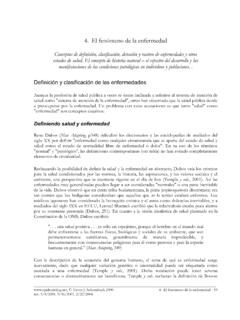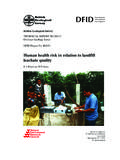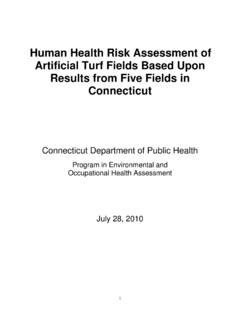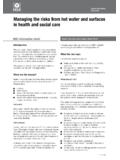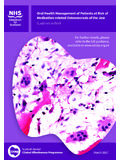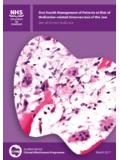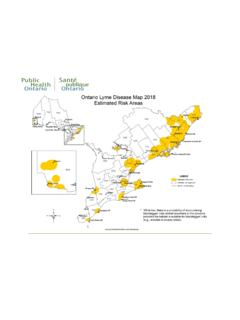Transcription of 7. Relating risk factors to health outcomes - epidemiolog.net
1 7. Relating risk factors to health outcomes Quantifying relationships between two factors or one factor and the occurrence, presence, severity, or course of disease The Big Picture . At this point in the course, it will be good to take stock of where we are and where we are going. After a brief overview of population and health , we have thoughtfully considered the phenomenon of disease in relation to how epidemiologists study disease. Under that topic we examined issues of definition, classification, and natural history. We then turned to the question of how to measure disease frequency and extent in populations. We examined some general issues in numeracy and descriptive statistics, and then took up the fundamental epidemiologic measures of prevalence and incidence, with the latter approached as a proportion or as a rate. From there we took up the topic of standardization, which facilitates comparisons between prevalence and incidence across populations with different demographic composition, and we saw how these various measures and concepts are used in descriptive epidemiology and surveillance.
2 For the next section of the course we will be concerned with how to investigate associations between health outcomes and potential risk factors . That task involves questions of study design, measures of association, validity, inference and interpretation. The topics of study design and measures of association are so intertwined that whichever one we begin with, it always seems that we should have begun with the other! Analytic studies provide the data for estimating measures of association and impact, but measures of association and impact motivate the design of the studies. However, the basic epidemiologic approach to Relating risk factors to health outcomes is more general than the specifics of either topic. Consider a population in which a disease or some other condition occurs throughout the population but more often in persons with characteristic A.
3 We are likely to be interested in how the existence (prevalence) or occurrence (incidence) of the disease among people with characteristic A compares with that for the population as a whole and for people with some other characteristic B (which could simply be the absence of A). To make this comparison we: a. Measure the frequency - prevalence, CI, ID - of the disease or condition in each group (and perhaps in the entire population);. b. Compare the frequencies (fairly! - , after standardization if necessary)). c. Quantify the comparison with a measure of association d. Quantify the potential impact of the characteristic on the condition, if we are willing to posit a causal relationship. We have already discussed measures of frequency and extent. Now we turn to measures of association and impact. _____. , Victor J. Schoenbach 2000 7. Relating risk factors to health - 161.
4 Rev. 3/6/2004, 10/30/2004, 1/24/2008, 3/3/2008. Measuring the strength of a relationship The question that summarized the preceding topic could be stated as How much of a factor is there? or How often does a disease (or other phenomenon) occur? . However, much of epidemiology is concerned with relationships among factors , particularly with the effect of an exposure on a disease . Therefore the present topic addresses the question How strong is the relationship between two factors ? or How strong is the relationship between a study factor and an outcome ? A relationship may be strong without being causal , and vice versa. Nevertheless, two factors that are strongly associated are more likely to be causally related. There are a number of ways in which the strength of the relationship between two variables can be assessed. We can, for example, assess the extent to which a change in one variable is accompanied by a change in the other variable or, equivalently, the extent to which the distribution of one variable differs according to the value of the other variable.
5 For this assessment, epidemiologists use a measure of association*. A second perspective is the extent to which the level of one of the factors might account for the value of the second factor, as in the question of how much of a disease is attributable to a factor that influences its occurrence. Epidemiologists use measures of impact to address this question. Most of the measures we will cover in this topic apply to relationships between a factor that is dichotomous (binary, having two possible values) and a measure of frequency or extent, in particular, a rate, risk, or odds. Such measures are the most commonly used in epidemiology. We will also touch on measures that are used in other situations. Measures of association A measure of association provides an index of how strongly two factors under study vary in concert. The more tightly they are so linked, the more evidence that they are causally related to each other (though not necessarily that one causes the other, since they might both be caused by a third factor).
6 Association - two factors are associated when the distribution of one is different for some value of the other. To say that two factors are associated means, essentially, that knowing the value of one variable implies a different distribution of the other. Consider the following two (hypothetical). tables: *. Although this term and measure of effect have frequently been used interchangeably ( , in this text), Rothman and Greenland (2000:58-59) draw the following distinction: associations involve comparisons between groups or populations; effects involve comparisons of the same population [hypothetically] observed in two different conditions;. measures of association are typically used to estimate measures of effect. _____. , Victor J. Schoenbach 2000 7. Relating risk factors to health - 162. rev. 3/6/2004, 10/30/2004, 1/24/2008, 3/3/2008.
7 CHD and oral contraceptives in Breast cancer (BC) and oral women age 35 years or more contraceptives OC No OC Total OC No OC Total CHD 30 20 50 Cancer 15 35 50. Non-case 30 70 100 Non-case 30 70 100. Total 60 90 150 Total 45 105 150. Consider first the table on the left (CHD and OC). The overall proportion of OC users is 60/150 =. , but that among CHD cases is 30/50 = while that among noncases is 30/100 = The distribution of values of OC use ( users , nonusers ) is therefore different for different CHD. values ( case , noncase ). Similarly, the distribution of values of CHD is different for different values of OC (30/60 of OC users have CHD; 20/90 of non-users of OC have CHD). If asked to estimate the proportion of OC users in a sample of 40 women selected at random from the table on the left, would we want to know how many in the sample had CHD and how many did not?
8 Indeed we would. We know that the proportion of OC users must be no lower than (if the sample consists entirely of noncases) and no greater than (if the sample consists entirely of cases). In the absence of knowing the proportion of cases, our best estimate would be the overall proportion in the population, But is we knew the proportion of cases in the sample, we could move our estimate up (if more than one-third were cases) or down (if fewer than one-third were cases). [Now, verify that to estimate the proportion of CHD cases in a random sample, we would want to know the proportion of OC users. What is the best estimate of the proportion with CHD if the sample consists of 22 OC users and 18 nonusers? The answer is at the end of this chapter.]. Thus, in the data in the left-hand table, there is an association between OC use and CHD. In contrast, in the table on the right (BC and OC), the distribution of OC use is the same for the cases, the noncases, and the entire group.
9 Therefore, the data in the right-hand table show no association between breast cancer and use of OC's. Correlation and Agreement Association is a general term that encompasses many types of relationships. Other terms are used to indicate specific types of association. Two important ones are: Correlation is a type of association in which the relationship is monotonic, , it goes in one direction - the more of one factor, the more of the other (positive or direct correlation), OR the more of one factor, the less of the other (negative or inverse correlation). Linear correlation (measured by the Pearson product-moment correlation coefficient) assesses the extent to which the relationship can be summarized by a straight line. Nonparametric correlation coefficients, such as the Spearman rank correlation coefficient, assess the extent to which the two factors are correlated _____.
10 , Victor J. Schoenbach 2000 7. Relating risk factors to health - 163. rev. 3/6/2004, 10/30/2004, 1/24/2008, 3/3/2008. but without regard to the size of the change in one that accompanies a change in the other, simply the direction. Agreement is a type of correlation in which the two factors (generally two measures of the same phenomenon) are not only directly correlated with each other but have the same actual values. For example, two sphygmomanometers should give the same readings when used on the same person on the same occasion, not merely readings that are correlated. Two measurements of a stable phenomenon should agree with each other, not merely correlate. If one of the measures is known to be highly accurate and the other is being assessed, then we can assess validity of the latter, rather than merely agreement between the two. ASIDE.
